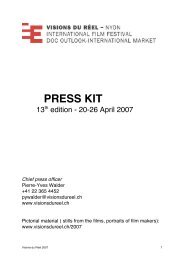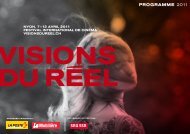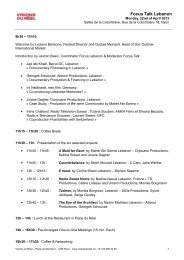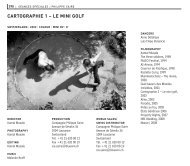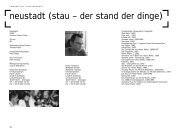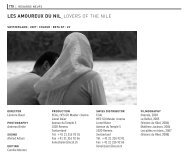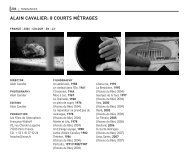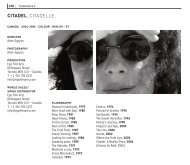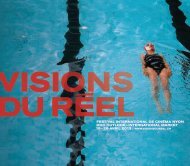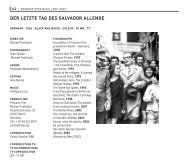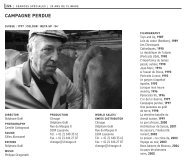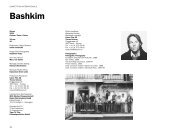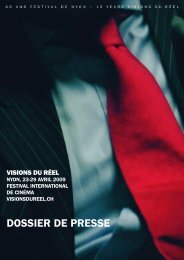masumi is a pc operator / fumiyo is a designer - Visions du Réel
masumi is a pc operator / fumiyo is a designer - Visions du Réel
masumi is a pc operator / fumiyo is a designer - Visions du Réel
You also want an ePaper? Increase the reach of your titles
YUMPU automatically turns print PDFs into web optimized ePapers that Google loves.
370 | ATELIERS | APICHATPONG WEERASETHAKUL<br />
MASUMI IS A PC OPERATOR / FUMIYO IS A DESIGNER<br />
THAÏLANDE/JAPON | 2001 | COLOUR | DV | 6’<br />
WORLD SALES/<br />
SWISS DISTRIBUTOR<br />
Kick the Machine<br />
Apichatpong Weerasethakul<br />
44/17 Ladprao 15<br />
Jatujak, Bangkok 10900<br />
Thaïlande<br />
Tél. +66 9 112 8576<br />
kickthemachine@softhome.net<br />
DIRECTOR<br />
Apichatpong Weerasethakul<br />
PHOTOGRAPHY<br />
Apichatpong Weerasethakul<br />
EDITING<br />
Apichatpong Weerasethakul<br />
PRODUCTION<br />
Kick the Machine<br />
Apichatpong Weerasethakul<br />
44/17 Ladprao 15<br />
Jatujak, Bangkok 10900<br />
Thaïlande<br />
Tél. +66 9 112 8576<br />
kickthemachine@softhome.net
APICHATPONG WEERASETHAKUL | ATELIERS | 371<br />
Ces deux vidéos d’Apichatpong Weerasethakul,<br />
Masumi <strong>is</strong> a PC Operator et Fumiyo <strong>is</strong> a<br />
Designer, font partie, avec quelques autres<br />
pièces, de l’installation «Narratives», montrée<br />
en 2001 à l’Intercross Art Center de Sapporo<br />
(Japon). Leur d<strong>is</strong>positif est identique: une<br />
série énigmatique de longs plans fixes muets<br />
<strong>is</strong>olent, sous divers angles de pr<strong>is</strong>es de vue, un<br />
personnage immobile au regard absent et ce<br />
qui l’entoure. Dans Masumi <strong>is</strong> a PC Operator,<br />
une femme se tient debout seule face à<br />
la fenêtre de son appartement. Dans Fumiyo<br />
<strong>is</strong> a Designer, elle est ass<strong>is</strong>e sur un banc<br />
public. Des musiciens de rues jouent de la<br />
guitare et chantent.<br />
Pour Apichatpong Weerasethakul, le cinéma<br />
ne repro<strong>du</strong>it pas la réalité ma<strong>is</strong> la retranscrit,<br />
en enreg<strong>is</strong>trant ce que l’œil humain ne peut<br />
voir. En fa<strong>is</strong>ant ainsi varier ostensiblement la<br />
position de la caméra, l’art<strong>is</strong>te interroge les<br />
processus de construction de la narration et<br />
d’identification propres à ce médium. Il br<strong>is</strong>e<br />
les codes classiques <strong>du</strong> récit, en déstructurant<br />
l’espace et le temps par des raccords<br />
improbables. Cette fragmentation des séquences<br />
et l’absence de bande sonore con<strong>du</strong><strong>is</strong>ent<br />
inévitablement le spectateur à combler les<br />
manques, à imaginer les pensées intérieures<br />
<strong>du</strong> protagon<strong>is</strong>te à l’écran et l’atmosphère de<br />
la scène. Comme dans le cinéma «open air»<br />
thaï, le public peut à l’aide d’un microphone,<br />
m<strong>is</strong> à la d<strong>is</strong>position des v<strong>is</strong>iteurs, la<strong>is</strong>ser libre<br />
cours à sa fanta<strong>is</strong>ie dans ce qui pourrait s’apparenter<br />
à un curieux karaoké cinématographique.<br />
(am)<br />
Die beiden Videos Masumi <strong>is</strong> a PC Operator<br />
und Fumiyo <strong>is</strong> a Designer von Apichatpong<br />
Weerasethakul gehören, zusammen mit<br />
einigen anderen Arbeiten, zu der Installation<br />
«Narratives», die 2001 im Intercross Art Center<br />
von Sapporo (Japan) gezeigt wurde. Ihre<br />
Anlage <strong>is</strong>t ident<strong>is</strong>ch: in einer Reihe rätselhafter,<br />
langer, fester und stummer Einstellungen<br />
werden aus verschiedenen Kamera-Blickwinkeln<br />
eine unbewegte Person mit abwesendem<br />
Blick und ihre Umgebung <strong>is</strong>oliert dargestellt.<br />
In Masumi <strong>is</strong> a PC Operator, steht eine<br />
Frau alleine am Fenster ihrer Wohnung. In<br />
Fumiyo <strong>is</strong> a Designer, sitzt sie auf einer<br />
öffentlichen Bank. Straßenmusiker spielen<br />
Gitarre und singen. Für Apichatpong Weerasethakul<br />
repro<strong>du</strong>ziert das Kino die Wirklichkeit<br />
nicht, sondern schreibt sie um, indem es<br />
aufzeichnet, was das menschliche Auge nicht<br />
sehen kann. Indem er die Kamerapositionen<br />
ostentativ wechselt, hinterfragt der Künstler<br />
die dem Medium eigenen Konstruktionsprozesse<br />
von Erzählung und Identifikation. Er<br />
bricht die klass<strong>is</strong>chen Erzähl-Codes, indem<br />
er die Strukturen von Raum und Zeit <strong>du</strong>rch<br />
unwahrscheinliche Übergänge auflöst. Diese<br />
Fragmentierung der Sequenzen und die Abwesenheit<br />
einer Tonspur führen den Betrachter<br />
unweigerlich dazu, die Leerstellen zu füllen,<br />
sich die Gedanken der Protagon<strong>is</strong>ten auf der<br />
Leinwand und die Athmosphäre der Szene vorzustellen.<br />
Wie im thailänd<strong>is</strong>chen Open-Air-Kino<br />
kann das Publikum mittels eines den Zuschauern<br />
zur Verfügung gestellten Mikrofons in einer<br />
Art seltsamen, cinematograf<strong>is</strong>chen Karaoke<br />
seiner Fantasie freien Lauf lassen.<br />
(am – Übersetzung: rna)<br />
Apichatpong Weerasethakul’s two videos,<br />
Masumi <strong>is</strong> a PC Operator and Fumiyo <strong>is</strong><br />
a <strong>designer</strong>, form part – together with a few<br />
others – of an installation called “Narratives”<br />
shown at the Sapporo Intercross Art Center<br />
in Japan in 2001. Their set-up <strong>is</strong> identical: an<br />
enigmatic series of mute static long shots<br />
taken from several angles single out an<br />
absent-looking immobile figure and its surroundings.<br />
In Masumi <strong>is</strong> a PC Operator, a<br />
woman stands alone at the window of her<br />
apartment. In Fumiyo <strong>is</strong> a Designer, she<br />
sits on a public bench. Street musicians play<br />
the guitar and sing. For Apichatpong Weerasethakul,<br />
cinema does not repro<strong>du</strong>ce reality.<br />
Rather, it transcribes reality by recording what<br />
the human eye cannot perceive. By ostensibly<br />
varying the position of the camera, the<br />
art<strong>is</strong>t questions the process of narration and<br />
identification specific to th<strong>is</strong> medium. He<br />
breaks the classic rules of narration by deconstructing<br />
time and space by linking them both<br />
in an improbable way. Th<strong>is</strong> fragmentation of<br />
sequences and the absence of a soundtrack<br />
in<strong>du</strong>ce the audience to fill the gaps and to<br />
imagine the inner thoughts of the protagon<strong>is</strong>t<br />
on the screen, as well as the atmosphere of<br />
the scene. Like in open-air Thai cinema, the<br />
spectators can give free rein to their imagination<br />
by means of a microphone put at their<br />
d<strong>is</strong>posal, thus creating a kind of bizarre cinematographic<br />
karaoke. (am – Translation: chu)



